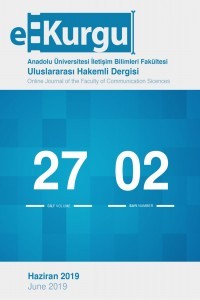Türkiye Dijital Kamusal Alanında Suriyeliler Söyleminin Bir Eleştirisi
Türk milliyetçiliği, İslami kardeşlik söylemi, göçmen karşıtı söylem, etnik kategorizasyon, Suriyeliler, Turkish nationalism, Islamic-brotherhood discourse, anti-immigrat discourse, ethnic categorization, Syrians.
A Critique of Discourse of Syrians in Turkish Digital Public Sphere
Turkish nationalism, Islamic-brotherhood discourse, anti-immigrat discourse, ethnic categorization, Syrians.,
___
- Akçam, T. (2008). Türk Ulusal Kimliği Üzerine Tezler, In; Tanıl Bora and Murat Gültekin. Modern Türkiye’de Siyasi Düşünce. (3. Baskı). İstanbul: İletişim Yayınları.
- Anderson, B. (1991). İmagined Community, London ve New York, Verso.
- Androutsopoulos, J. (2008). Potentials and Limitations of Discourse-Centred Online Ethnography, language@internet, Retrieved 06 January 2020 from https://www.languageatinternet.org/articles/2008/1610.
- Fernández, M., A. (2017): Platformed racism: the mediation and circulation of an Australian race-based controversy on Twitter, Facebook and YouTube, Information, Communication & Society.
- Balibar, E. (1991). Racism and Nationalism, (C. Turner, Çev.). Balibar, E. ve Wallerstein, I. Race, Nation, Class Ambigious Identities içinde (243- 291), London, New York: Verso.
- Bennett W. L, Livingston S. (2018). The disinformation order: Disruptive communication and the decline of democratic institutions. European Journal of Communication.33(2):122-139.
- Billig M (1995) Banal Nationalism. London: Sage.
- Bimber B, Gil de Zúñiga H. (2020). The unedited public sphere. New Media & Society. 22(4):700-715.
- Bozdağ, Ç. (2019). Bottom-up natinalism and discrimination on social media: An analysis of the citizenship debate about refugees in Turkey, European Journal of Cultural Studies, p. 1- 19. Erişim 22 Mayıs 2020, https://doi.org/10.1177%2F1367549419869354.
- Dahlgren, P. (2005) The Internet, Public Spheres, and Political Communication: Dispersion and Deliberation, Political Communication, 22:2, 147-162.
- Datts, M. (2020). Social Media, Populism, and Migration. Media and Communication, 8(4), Pages: 73-83.
- De Blasio, E, Marianne, K., Wolf J. S., and Michele S. (2020). The Ongoing Transformation of the Digital Public Sphere: Basic Considerations on a Moving Target, Media and Communication, 8(4), Pages 1–5.
- Ekman, M. (2019). Anti-immigration and racist discourse in social media. European Journal of Communication, 34(6), 606–618. doi:10.1177/0267323119886151.
- Eriksen, T., H. (1993). Formal and informal nationalism, Ethnic and Racial Studies, 16:1, 1-25.
- Fairclough, N. (2010). Critical Discourse Analysis, (First Published: 1995). London: Routledge.
- Filibeli, E., T., Ertuna, C. (2021). Sarcasm Beyond Hate Speech: Facebook Comments on Syrian Refugees in Turkey. International Journal of Communication, 15(2021), 2236- 2259.
- Habermas, J. (2006). Political Communication in Media Society: Does Democracy Still Enjoy an Epistemic Dimension? The Impact of Normative Theory on Empirical Research. Communication Theory, 16(4), 411–426.doi:10.1111/j.1468-2885.2006.00280.x.
- Hine, C. (2000). Virtual Ethnography, London: Sage.
- Hine, C. (2017). From Virtual Ethnography to the Embedded, Embodied, Everyday Internet, Edt: Hjorth L., Heather H., Anne G., ve Genevieve B. İn The Routhledge Companion Digital Ethnography, New York; Routledge (pp. 21-29).
- KhosraviNik, M., Zia, M. (2015). Persian Nationalism, Identity and Anti-Arab Sentiments in Iranian Facebook Discourses: Critical Discourse Analysis and Social Media Communication. Occupy, 13(4), 755–780.
- Kreis R. (2017). #refugeesnotwelcome: Anti-refugee discourse on Twitter. Discourse & Communication. 11(5):498-514.
- Ozduzen, O., Korkut, U., & Ozduzen, C. (2020). “Refugees are not welcome”: Digital racism, online place-making and the evolving categorization of Syrians in Turkey. New Media & Society.
- Özkırımlı, U. (2008). Türkiye’de Gayriresmi Milliyetçilik ve Popüler Milliyetçilik, In; Tanıl Bora and Murat Gültekin. Modern Türkiye’de Siyasi Düşünce. (3. Baskı). İstanbul: İletişim Yayınları.
- Pere, M. Carlos, R., C, Jaume, S. (2019). “Active audiences and social discussion on the digital public sphere. Review article”. El profesional de la información.
- Pink, S., Horst, H., Postill, J, Hjorth, L, Lewis, T., Tacchi, J. (2016). Digital Ethnography Principles and Practice, London: Sage.
- Polat, R. K. (2018). Religious solidarity, historical mission and moral superiority: construction of external and internal “others” in AKP’s discourses on Syrian refugees in Turkey. Critical Discourse Studies, 1–17.doi:10.1080/17405904.2018.1500925.
- Pond, P., Lewis J. (2017). Riots and Twitter: connective politics, social media and framing discourses in the digital public sphere, Information, Communication & Society, DOI: 10.1080/1369118X.2017.1366539.
- Saraçoğlu, C., Belangar D. (2019). Loss and xenophobia in the city: contextualizing anti- Syrian sentiments in İzmir, Turkey, Patterns of Prejudice, 363- 383. Erişim 30 Mayıs 2021, https://doi.org/10.1080/0031322X.2019.1615779.
- Schlesinger P. (2020). After the post-public sphere. Media, Culture & Society. 42(7-8):1545-1563.
- Unger J, Wodak R, KhosraviNik M. (2016). Critical Discourse Studies and Social Media Data. In: David Silverman, ed. Qualitative Research (4.Print). London: SAGE.
- Van Dijk, T. (2018). Discourse and Migration, Z. Barrero, ve E. Y. Yalaz, (Ed.). Qualitative Research in European Migration Studies içinde (227- 247). Erişim 29 Mayıs 2020, http://www.springer.com/series/13502.
- Voloder, L. (2013). Secular citizenship and Muslim belonging in Turkey: migrant perspectives, Ethnic and Racial Studies, 36:5, 838-856.
- Wodak, R. (2001) The discourse historical approach. In: Wodak R and Meyer M (eds) Methods of Critical Discourse Studies. London: Sage, pp.63-95.
- ISSN: 1309-3487
- Başlangıç: 2014
- Yayıncı: Anadolu Üniversitesi
ÜNİVERSİTELERDE HALKLA İLİŞKİLER FAALİYETLERİNİN ÖRGÜTSEL BAĞLILIĞA OLAN ETKİSİNİN DEĞERLENDİRİLMESİ
Ahmet Ozan ŞENER, Erhan EROĞLU
Türkiye'deki Z Kuşağının Video Akış İşçiliği, Dijital Eğlence Emeği ve Medya Mesaisi
Tekerrür, Adalet ve Kardeşlik Kavramları Işığında Kieslowski'nin Kırmızı'sı
Türkiye Dijital Kamusal Alanında Suriyeliler Söyleminin Bir Eleştirisi
FLÂNEUR’DEN POSTMODERN TÜKETİCİ BİREYE DÖNÜŞÜM SÜRECİNDE TÜKETİM KÜLTÜRÜ KAVRAMI VE GELİŞİMİ
